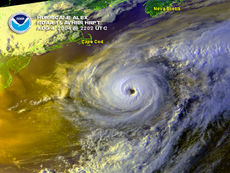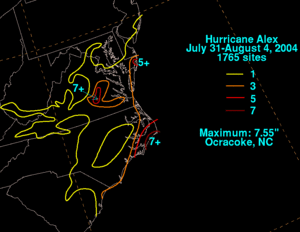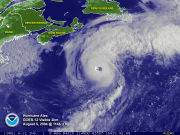Hurricane Alex (2004)
2007 Schools Wikipedia Selection. Related subjects: Natural Disasters
| Category 3 hurricane ( SSHS) | ||
|---|---|---|
|
Satellite image of Hurricane Alex just off the Outer Banks of North Carolina on August 3. |
||
| Formed | July 31, 2004 | |
| Dissipated | August 6, 2004 | |
| Highest winds |
|
|
| Lowest pressure | 957 mbar ( hPa) | |
| Damage | $7.5 million (2004 USD) | |
| Fatalities | 1 direct | |
| Areas affected |
Outer Banks of North Carolina | |
| Part of the 2004 Atlantic hurricane season |
||
Hurricane Alex was the first named storm, the first hurricane, and the first major hurricane of the 2004 Atlantic hurricane season. It never made landfall, but the centre approached within 10 miles (16 km) of the North Carolina coast. Alex, the first storm of the season, formed unusually late in the season, the 5th latest since 1954. Unusually, Alex strengthened to a Category 3 hurricane on the Saffir-Simpson Hurricane Scale while off the coast of New England.
The hurricane produced light damage in the Outer Banks, primarily from flooding and high winds. Over 100 houses were damaged, while numerous cars were disabled from the flooding. Damage totaled about $7.5 million (2004 USD). Alex produced strong waves and rip tides along the East Coast of the United States, causing one death and several injuries.
Storm history
A weak surface trough, located to the west of an upper level low, developed convection to the east of the Bahamas on July 26. A tropical wave entered the area two days later, resulting in an increase of convective organization and area. It moved to the northwest and steadily organized, developing a surface area of low pressure on the 30th. On July 31, the system continued to organize, and developed into Tropical Depression One while located 200 miles (320 km) to the east of Jacksonville, Florida.
As the depression drifted erratically, the system remained weak, due to its large circulation and lack of deep convection near the centre. The centre relocated to the south , closer to the centre. An approaching upper level trough lessened the shear over the system, allowing the depression to intensify into Tropical Storm Alex on August 1. The trough also caused Alex to increase its forward motion to the northeast. Deep convection continued to build over the centre due to low shear and warm waters from the Gulf Stream, and Alex intensified into a hurricane on August 3 while 75 miles (120 km) southeast of Cape Fear, North Carolina. Hurricane Alex continued to strengthen, and attained Category 2 hurricane status just hours after becoming a hurricane. The hurricane approached the Outer Banks of North Carolina, coming within 10 miles (16 km) of Cape Hatteras later on the 3rd. The western eyewall was over land, but the centre remained offshore.
Alex turned to the east-northeast after passing the Outer Banks in response to becoming embedded within the west-southwesterly flow. The hurricane briefly weakened to a Category 1, but restrengthened due to warm waters of the Gulf Stream. Water temperatures remained 2º C above normal, resulting in Alex to intensify into a 120 mph (195 km/h) major hurricane on August 5 while only 450 miles (710 km) south of Halifax, Nova Scotia. Due to low vertical shear and favorable conditions, Alex remained a Category 3 hurricane until passing over cooler waters late on the 5th while 290 miles (465 km) south of Newfoundland. Alex rapidly weakened, degrading into tropical storm status on August 6. Later on the 6th, Alex became extratropical while 950 miles east of Cape Race, Newfoundland, and lost its identity shortly thereafter.
Preparations
Initially, forecasters believed Alex would remain weak, with the storm making landfall as a minimal tropical storm. However, when strengthening became apparent, the National Hurricane Centre issued a Hurricane Warning from Cape Lookout to Oregon Inlet about 20 hours before hurricane conditions were experienced. In addition, a tropical storm warning existed for much of the North Carolina coastline as Alex moved by.
Despite Tropical Storm Warnings, tourists on the Outer Banks remained to enjoy the beach. However, many planned to leave if Alex would come closer or become stronger. Because Alex was expected to be relatively minor, about 3,500 tourists remained on the Outer Banks. In addition, there was no evacuation order. Due to Hurricane Isabel hitting the area less than a year earlier, officials recommended residents to take precautions for the approaching hurricane. The National Weather Service in Morehead City issued a flash flood watch a day before the hurricane moved passed the Outer Banks. They also issued flash flooding warnings on the 3rd for Craven and Carteret Counties.
In preparation for the hurricane, the Cape Lookout National Seashore was closed and evacuated. The National Park Service also closed Cape Point Campground.
Impact
The worst of Hurricane Alex's effects occurred along the Outer Banks, primarily near Ocracoke. Damage totaled to $7.5 million, and was limited to flooded cars and houses. The hurricane caused strong waves and rip currents for days, causing one death and several injuries.
North Carolina
While drifting off the coast of Florida, Alex produced rip currents and strong waves along the North Carolina, resulting in nine lifeguard rescues from the surf. Upon moving by the Outer Banks, a storm surge of up to 6 feet (1.8 m) occurred on the Pamlico Sound side of Buxton and Ocracoke Village. The flooding on Ocracoke Island was the worst since Hurricane Gloria nineteen years earlier. Elsewhere on the Outer Banks, waters rose 2 to 4 feet (.6 to 1.2 m) above normal. Rainfall directly along the coast amounted to over 5 inches (127 mm), while Okracoke experienced 7.55 inches (192 mm). Maximum sustained winds peaked at 77 mph (124 km/h), while gusts peaked at 105 mph (169 km/h) in Hatteras Village. Beach erosion was minor along much of North Carolina's coastline, with the exception of Okracoke Island where erosion was significant.
Cape Fear experienced minor beach erosion. The erosion, combined with waves, washed out a portion of a roadway. The heavy rainfall in the Outer Banks disabled over 200 cars, and flooded nearly 500. Strong wind gusts left around 10,000 buildings without power . Many places were not restored for 2 to 3 days after the storm. Wind and storm surge damaged over 100 houses and buildings. Damage totaled to about $7.5 million (2004 USD). Two days after the storm passed, strong rip currents and waves off of Nags Head, North Carolina drowned a man, the only direct casualty from the storm.
Elsewhere
Alex's outer rainbands produced heavy rainfall across Virginia, peaking at over 7 inches (178 mm) in the centre of the state. The rainfall caused localized flooding throughout the state, but no reported damage.
In Rehoboth Beach, Delaware, rip currents produced by the storm injured three people. A few young children had to be rescued when they were trapped by a jetty. In New Jersey, the strong surf and rip currents hospitalized at least five swimmers.
Alex's extratropical remnants sank the Pink Lady, a rowboat carrying four British rowers attempting to break the record for fastest crossing from St. John's, Newfoundland to Falmouth, Cornwall. They were rescued by a Danish cargo ship, and injuries were limited to a mild concussion and a case of hypothermia. The rowers were roughly two weeks and 370 miles (595 km) from their destination. The group had been on track to break the 1896 record of 54 days by 10 days.
Aftermath
On Ocracoke Island, officials ordered for the evacuation of the thousands of tourists who stayed, believing that keeping tourists in the island would hinder cleanup efforts. The tourists were evacuated in school buses to Hatteras Island, where they could rent a car if needed. The island was re-opened to visitors on the 6th, three days after the storm passed through. Dare County requested aid from the National Guard for the cleanup process, while the North Carolina Department of Transportation was ready to clear the roads once the storm exited the area.
Due to the low damage, the name Alex was not retired and it will next be used in 2010.
Records
Alex marked the fifth-latest start to a hurricane season since 1954. The latest start to a hurricane season since 1954 was Hurricane Anita of the 1977 season, forming on August 29. However, during the 1914 season, the only known storm of the season formed on September 14.
Alex is only the second hurricane on record to have reached Category 3 strength north of 38°N latitude. The other storm was Hurricane Ellen in the 1973 Atlantic hurricane season; Alex was the stronger of the two.




